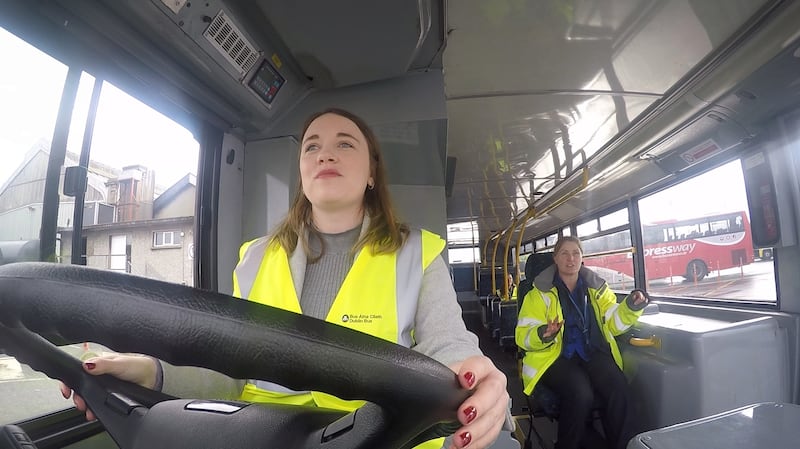The wheels on the bus are going round and round, and suddenly I realise I am in charge of steering this thing. To my right is a row of parked buses. To the left, cars. Well, at least there’s nothing important or expensive in the vicinity if anything goes awry.
“It’s just like driving your car, but only a little bit bigger,” says Tina Ahern, a Dublin Bus instructor and driver, who is teaching me how to operate the vehicle.
Given my first car was a Mini Cooper, I’d say a “little bit bigger” is only a slight understatement.
Dublin Bus last week launched its More Mná campaign, which seeks to recruit more women drivers. Currently, just 6 per cent of Dublin Bus drivers are women, 193 out of more than 3,000.
Research conducted by the transport company found jobs perceived as “male” roles were off-putting for many women when seeking employment.
Just because you have made it around the corner smoothly, doesn’t mean the back of the bus has
Vivienne Kavanagh, talent development and diversity manager at Dublin Bus, believes the underrepresentation of women in driving positions is a result of “perceptions” of the role.
“People maybe think it’s physically difficult to drive a bus, which it’s not. People might be worried about safety but it’s a very safe job. You have your cab that has the screen, you have your emergency button to contact central control. And then maybe people don’t see that many women drivers so they don’t think it’s a job for them,” she said.
That narrative is something Dublin Bus wants to change. And after driving a bus, it’s easy to see why. I take the handbrake off, and ease my foot off the foot brake, as the automatic bus begins to propel itself forward.
Side mirrors, I quickly discover, are invaluable in a vehicle of this length. Just because you have made it around the corner smoothly, doesn’t mean the back of the bus has. Thankfully, no cones or kerbs were harmed during this exercise.
For a bus so large, however, manoeuvring it is surprisingly easy. Often a little adjustment of the steering wheel goes a long way.
The Netflix show Drive to Survive might have sparked enormous interest in Formula 1 racing, but clearly viewers have never seen me in a red and white training bus doing circuits around the Broadstone depot in north Dublin.
“Slow down a bit now,” Ahern says in a calming tone. Given my driving lessons for my full licence involved a lot of raised or panicked voices from my poor parents in the passenger seat, her composure is appreciated as I press too hard on the more sensitive air brakes, bringing all of us to a sudden halt.
“Ooh sorry,” I reply looking guilty, as our poor cameraman falls forward towards the front of the bus with a thud, due to the unexpected change in motion. Sorry, Bryan. My bad.
“You’re okay, just go again,” Ahern reassures me, though I don’t believe her for a second. “The brakes are a lot more sensitive, but you’ll get used to them.”
[ Driving the bus is easy, but how do I turn on Radio Nova?Opens in new window ]

To become a bus driver, applicants must have a two-year full licence, and complete a driving assessment in the Dublin Bus training centre. Once accepted on to the programme, drivers receive six weeks’ training – two weeks in the classroom and four weeks on the road.
“The very first day, it’s just an introduction about what the six-week course is going to be about,” Ahern says.
“You’re given your uniform on the Monday. And then on the Tuesday morning, they expect you to come in in uniform. You feel like a bus driver then, you’re shown how to drive a bus and you’re driving it from then.”
After the course, drivers must do their test with the Road Safety Authority (RSA). Once they have passed, they are appointed a garage and a mentor who guides them on routes, beginning with “nursery” – easier – routes, before further routes are introduced.
“You’re not just thrown in at the deep end, you’re given a lot of help along the way,” Ahern adds.
After 40 minutes of driving around the depot, Ahern instructs me to reverse around a corner, before parking the bus in an allotted spot.
You pick up the basics fairly quickly, and become much more confident by the end of the drive. Thankfully, there were no further potential whiplash-inducing incidents; Ahern was right, you do quickly get used to the brakes.
“Right, are you ready to go out on to the road?” Ahern asks me, to which I quickly reply: “No, thank you.”
I think it’s better to leave that to the professionals or those officially in training; moving around stationary objects is one thing, but avoiding moving objects or vehicles seems like a lesson for another day. I guess I’ll stick with my day job for now.
- Sign up for push alerts and have the best news, analysis and comment delivered directly to your phone
- Find The Irish Times on WhatsApp and stay up to date
- Our In The News podcast is now published daily – Find the latest episode here












